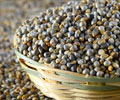Oats is a highly nutritious cereal, which can be tolerated by large number of celiac patients. A range of commercial oat flours as well as specific oat flours produced from single
Oats is a highly nutritious cereal, which can be tolerated by large number of celiac patients. A range of commercial oat flours as well as specific oat flours produced from single varieties have been evaluated for their suitability for bread-baking. Enzyme technology, bioprocessing as well as high-pressure processing technology have been successfully applied to improve the quality, safety and nutritional attributes of oat based foods.
The interest in oats for human nutrition is growing due to its exceptional nutritional quality. In fact, the health effects of oats rely mainly on the total dietary fibre and β-glucan content, which reduce postprandial blood glucose and insulin responses and lower blood lipids, especially serum total and LDL-cholesterol. Besides β-glucan, oats also contain high amounts of other valuable nutrients such as proteins, unsaturated fatty acids, vitamins, minerals and antioxidants. Moreover, recent studies have shown that oats can be tolerated by most people suffering from celiac disease.Bread, mostly made from wheat, is an essential constituent of the human diet and the nearly ubiquitous consumption places it in a position of global importance. Thus, the development of 100% oat bread could enhance the range of products suitable for people affected by celiac disease and satisfy the consumer demand for diverse and healthy foods. Yet, oat proteins do not possess the unique visco-elastic properties characteristic for wheat gluten, thus oat doughs resemble cake batters rather than bread doughs. Furthermore, most studies investigating the effect of oats on bread quality were previously conducted on composite breads, containing significant amounts of wheat which masked bread making properties of oats.
Consequently, the objective was to establish the properties of oats required for the production of high quality oat bread by exploiting a combination of baking, rheological and analytical chemistry techniques. The bread making properties of commercial oat flours as well as oat varieties were investigated on simple flour/water mixtures without addition of wheat or structure forming agents in order to avoid synergistic effects with functional ingredients. Moreover, sourdough fermentation and Hydrostatic Pressure (HP) processing were investigated for their potential to improve oat breadquality.
The results showed significant differences in the bread making performance of commercial oat flours. Overall, it was established that in order to achieve high quality oat bread wholegrain oat flours should present low batter viscosity, low flour water hydration capacity, starch content of above 65%, protein content of about 12%, low starch damage and coarse particle size. In addition, it was assessed whether certain oat varieties yield better quality bread than others by investigating their bread making properties under optimised conditions, which allowed the evaluation of oat constituents affecting oat bread quality.
Considerable differences were observed in the bread crumb structure which could be attributed to protein and fat content, starch properties as well as α-amylase activity. Hence, selection of oat varieties in relation to their composition is essential in order to obtain superior oat bread quality.
In addition, the effect of sourdough on oat bread quality was investigated. Oat sourdoughs were produced by spontaneous fermentation and subsequent back-slopping until a stable microbiota was obtained. Identification of the lactic acid bacteria showed dominance of strains which are not commonly found in wheat or rye sourdoughs. Yet, application of these strains as starter cultures for oat sourdoughs used for oat bread production revealed positive effects on loaf volume as a result of gas production by heterofermentative LAB, softening of the doughs and changes in the starch pasting properties.
Advertisement
The work formed part of the European Union project HEALTHGRAIN, and was conducted by the research team of Professor Elke Arendt, University College Cork, Ireland. Part of the microscopical analysis of the oat flours and breads was conducted by the team of Professor Kaisa Poutanen, VTT Technical Research Centre of Finland.
Advertisement
Source-Eurekalert
TAN















